American Tower to Install Dielectric Adaptive Polarization Tech Antennas
RAYMOND, Maine—Two Dielectric stacked antenna arrays with Adaptive Polarization Technology (APT) are on their way to American Tower for use in Dallas and Boston as part of the FCC-mandated TV spectrum repack, the company announced today.

APT enables broadcasters sharing an antenna array to select their own polarization ratio regardless of what other stations operating on the same array choose to do. Adding a vertical component improves reception of both ATSC 1.0 and 3.0 signals.
“Most antennas of this nature require that the polarization ratio is defined and locked in upfront,” said Dielectric VP of sales Jay Martin.
However, the arrays destined for American Tower are anchored by Dielectric’s TUM-APT series UHF panel antennas for the vertical real estate company’s master antenna TV station clients, while customized antennas for other stations are on top of the stack.
“The TUM-APT panel antenna offers our customers an enormous advantage by allowing for polarization ratio changes inside the transmitter room. And while these arrays are optimized for ATSC 3.0 broadcasting in the future, they will provide increased power density to improve indoor reception for today’s ATSC 1.0 broadcasts,” said Martin.
A dual-channel, center-fed elliptically polarized TFU series UHF array for KUVN-DT and KSTR-DT tops the stack in the Dallas setup, while the Boston installation for WGBY-DT adds a circularly polarized TDM series VHF array above the TUM-APT, according to Dielectric.
The design of the stacked arrays offers improved azimuth pattern performance when compared to traditional main and side-mount antennas, which can disrupt the azimuth pattern and cause reception problems due to the tower, the company said.
Get the TV Tech Newsletter
The professional video industry's #1 source for news, trends and product and tech information. Sign up below.
Stacking the arrays enables them to be top-mounted and unencumbered by the tower, eliminating tower scattering effects and allowing for a stronger, interference-free pattern, the company said. The TUM-APT design also locates the transmission line for the top-mount inside the mast, eliminating distortions to the azimuth pattern associated with locating the line outside the mast as is traditional.
Following the installation of a TUM-APT panel antenna, station engineers have the ability to optimize antenna polarization in the combiner room with no modifications to the antenna required, Dielectric said.
This feature is well suited for stations wishing to use the TUM-APT with horizontal polarization today but planning to add elliptical or circular polarization in the future to support signal delivery to mobile devices under ATSC 3.0, it added.
The antennas headed to American Tower have the bandwidth and high-power handling capability to accommodate more stations and their specific polarization needs in the future, the company said.
The TUM-APT structure is designed to support the weight of stacking an additional array on top due to splines designed to support both arrays from a single installation point. Both antennas are designed to be lifted by helicopter to expedite installation. The antennas are due to go on air in the summer, the company added.
For more information on the repack, visit TV Technology's repack silo.
Phil Kurz is a contributing editor to TV Tech. He has written about TV and video technology for more than 30 years and served as editor of three leading industry magazines. He earned a Bachelor of Journalism and a Master’s Degree in Journalism from the University of Missouri-Columbia School of Journalism.
